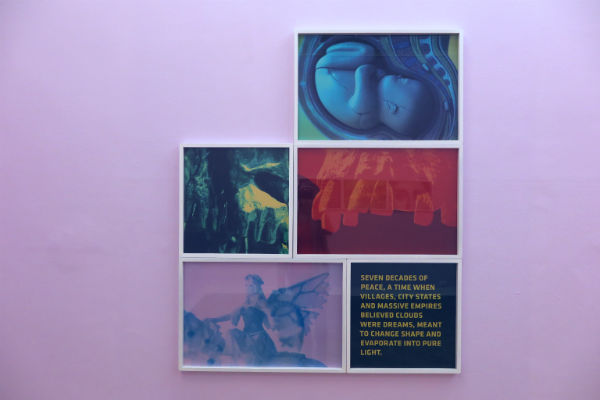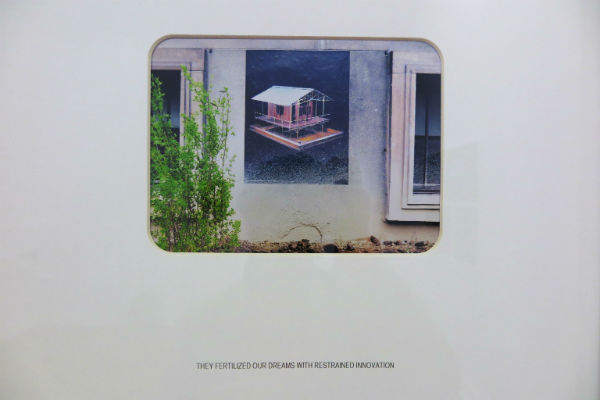‘Two Ghosts Discuss Invisibility in Front of a Mirror.’ The telling title is the first entryway to an exhibition in which two artists are in discourse on time, memory, absurdity, and failures.
Basim Magdy’s current exhibition at Gypsum includes the artwork of his father Magdy El-Gohary and sparks layers of connections in the spaces between both their works. The show is both a visual and intellectual pleasure, like a treasure hunt with lots of room for personal interpretations.
On display are a number of Gohary’s paintings dated between 1965 and 1968, and one from 2016.
These are interspersed among Magdy’s works, which pair photography and text; Every Subtle Gesture (2012), and Someone Tried to Lock Up Time (2018).
Two of his videos screen back-to-back in a separate room; No Shooting Stars, and The Everyday Ritual of Solitude Hatching Monkeys, which was inspired by his father’s poetry.

Someone Tried to Lock Up Time (Clouds are Dreams) by Basim Magdy, 2018 - ongoing
Three C-prints from chemically altered slides on Fujiflex metallic material.
Two dreams in one
The motivation for this dual display was primarily driven by sentiment and Magdy’s wish to showcase his father’s rarely seen work.
“I don’t know how much his work influenced me, or exactly how. But growing up surrounded by his artwork surely impacted me,” Magdy told Ahram Online.
It is not only about sharing one of his earliest artistic influences, but also the excitement of sparking a fresh and interesting dynamic found in the relationships between both artworks.
“I wanted to show what I felt were his most powerful works, and also those that intuitively linked with what I was doing now,” Magdy said.
Gohary’s ‘High Dam’ collection comprises impressionistic paintings of the High Dam in Aswan while still in early stages of construction.
Beyond documenting an iconic moment in time, the impressions speak quietly of “grand projects and collective aspirations, and also the poignancy of how they disappoint or fail,” as Magdy points.
His 100-piece work ‘Every Subtle Gesture’ was also triggered by similar emotions; the January 2011 revolution and its epic dreams and failures. The work was not about the revolution as such, but a starting point for the artist to explore a new means of expression.
“I pretend to be someone else and detach myself from my memory of the image, then write the new imagined story as one line,” he says of his process.
The text's random absurdism and playful objectivity invite us to make sense and connections in what holds neither of these things.
“Distractions brought clarity,” reads a verse in No Shooting Stars.
You find yourself torn between relishing the lushness of the dream-like imagery, and the desire to take it in slowly to make sense of connections meant to challenge expectations.
Are dreams prophetic or a coping mechanism? In Magdy’s work, they feel like both at once.

Works by Magdy El Gohary; The Old Cold Legend (left), gouache on paper (1968), and The Birds (right)
Watercolor and ink on paper (2016)
Time and seek
The exhibition is a dialogue of subtleties for those intrigued to unravel connections and spend time with the work.
Time itself plays a key role in unlocking and/or engaging with Magdy’s work, whether directly mentioned in the texts, or indirectly as an underlying theme and point-of-interest for the artist.
‘It was as if time had gone into hiding’ - reads one of the lines in the video The Everyday Ritual of Solitude Hatching Monkeys. The exhibition experience does feel like hide-and-seek with time.
In a 2013 interview, Magdy spoke about how he became more aware of his father’s influence on his life and work and how it felt as if “time functioned in cycles, inescapable and incomprehensible.”
Time is elusive, but it ties everything together, and on celluloid it is captured for the artist to examine, manipulate and display on a loop until the absurd starts to, somewhat, make sense.
The first work by Gohary that we encounter upon entering the gallery is named 'The Green Paper has Dried’ (1968).
The cubistic gouache painting features a white figure in the foreground holding a tiny leaf in its palm, against a background of crisp primary colours, with buildings that resemble computers.
The title carries a hint in its reference to the passage of time, which works on different levels; the time it takes for green to dry - between spring and autumn - and the fact that it is an event of the past.
It is placed right next to Magdy’s piece ‘Generation S,’ one of the pieces within ‘Someone Tried to Lock Up Time’.
Three images and a text on a ‘fantasy stained with selfies’ make up a visual riddle that cuts to the heart of Basim’s many questionings; what do we look like to the future? And what are the stories we are sending it?
The stories are ‘stained’ and manipulated, much like the pickled film and chemically-altered slides that Magdy uses in his photography.
Of all the visual formats he works with, the films are the most narrative.
And yet there are mentions of a certain “here” and "now" which we never know where to place, so it becomes about everywhere, all the time.
Both videos in the show have a hypnotising looseness. As if text and video are parallel narratives that may or may not converge occasionally.
He mocks the structures we take for narratives, and the narratives we take for realities, then take for truth. Perhaps the “entertainment lab” he mentions in ‘No Shooting Stars’ is just his studio.

Someone Tried to Lock Up Time (The Ruler Won't Live Forever) by Basim Magdy, 2018 - ongoing
Three C-prints from chemically altered slides on Fujiflex metallic material.
Tangible distances
The different mediums on display bring forth the interplay between paintings and photography as they compare and contrast.
Magdy El-Gohary’s works are hand drawn or painted, making the artist’s physical presence very palpable.
All his works are sized around 35 x 25 cm, which draw us in closer to see the details. In contrast, Magdy has us taking a few steps back to take in his work from afar.
The nature of photography and video work assumes a certain distance from the final outcome; there is an apparatus - the camera - between us and the artist. (To the same effect there is also a keyboard that he uses for his texts.)
However, Basim’s approach and involvement with it is very hands on. The Fujiflex metallic material and film celluloid are both very sensitive surfaces that are changed by everything they get in contact with. This makes his contact with the material also palpable, albeit differently than it would be in a painting.
The only hand painted piece by Basim in this show is a 2009 work on paper titled ‘We are Here Tonight to Celebrate our Unknown Ancestors.’
Having both artists’ paintings in the same exhibition invites, and even entices, this comparison.
“I wanted to show what I do in painting, in relation to my father’s paintings. They might even share some aesthetic quality, and underlying themes,” Magdy explained.
The clarity of the lines, the brightness of the colours while tackling existential, fatalistic themes, and an underlying sensitivity for time are some of the aspects they both share.
Two of Gohary’s pieces, The Old Cold Legend (1968) and The Birds (2016) displayed next to each other appear like illustrations of futuristic folk tales. It could be the same ongoing tale, despite being dated 48 years apart. Two faces at the bottom half of The Birds echo a photo of a Fayoum Portrait taken by Magdy, displayed in the same room.

Close up of a piece from Every Subtle Gesture, Basim Magdy, 52 x 45 cm
Color prints on Fuji Crystal Archive papered letterpress silver text.
Irises and infinity
Ironically, Magdy’s Super 8 cameras and 16mm films are mediums of the past - dead by modern standards - but the possibilities for renewal and manipulation are infinite, defying time and in a way cheating death.
In his last Cairo exhibition within D-CAF festival (2015), his photos in ‘The Colour Spectrum of a Post-Apocalyptic Future Landscape’ and his video ‘My Father Looks for an Honest City’ both featured earthy scenes and barren landscapes, and vacant lands of trees and mountains.
The visuals are different now in ‘Someone Tried to Lock Up Time’ as he picks up his macro lens, making everything feel more intimate.
As you look through the exhibition, you may begin to notice how it’s returning the gaze.
There is an abundance of eyes in the exhibition, most of which are looking straight at us; bold eyes with electric blue eyeliner, shy eyes, cropped eyes, painted ones, stone ones, and even fish eyes.
Magdy is always adding an element in his work that wasn’t there before, and this collection of eyes was intuitive until it became intentional.
“As I took many photos of people I found that I was always drawn to the eyes. They were the most interesting part of the face.”
Context fuels the work. Even a blurry image of the world resembles an iris in ‘Double Earth’ surrounded by all those eyes.
His photography works are arranged differently for every show, and can produce an infinite number of combinations, so different people would see the work coloured by different contexts.
In ‘Double Earth,’ instead of his usual typed text there is a photograph of sentence that seems written by finger. It feels like an inside joke we share with the artist as he breaks his format.
In the same room, Fish Tongue is the title of a work where the fish really has no tongue. It is rather placed strategically so that the fish itself becomes the tongue of a stone statue’s face in the adjacent frame.
Sticking its tongue out, the display concludes with a playful, teasing gesture, like a magician’s final trick.

Someone Tried to Lock Up Time (Double Earth) (left), and Someone Tried to Lock Up Time (Fish Tongue) (right) by Basim Magdy
C-prints from chemically-altered slides on Fujiflex metallic material
Programme:
The show is running until 20 February
Gypsum Gallery, 5 Ibrahim Naguib, Ground Floor, Apt 2, Garden City, Cairo
For more arts and culture news and updates, follow Ahram Online Arts and Culture on Twitter at @AhramOnlineArts and on Facebook at Ahram Online: Arts & Culture
Short link: